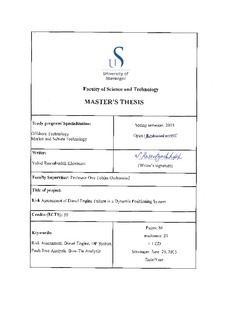| dc.description.abstract | The high demand for hydrocarbons as the major source of energy has forced humans to expand the oil and gas industry beyond the shore. Because of the challenges of oil and gas exploration and production in deep waters, the marine and offshore industry is becoming heavily reliant on Dynamic Positioning (DP) systems.
This study aims to demonstrate how a slight defect (that are often ignored in offshore DP operations) in ordinary and secondary components of a vessel’s system can cause a significant failure in a Dynamic Positioning system and consequently lead to a catastrophe.
The DP system, including various sub-systems, DP classes and applications, are introduced and discussed. In addition, the concept and procedure of risk management and its major steps (risk analysis, risk evaluation and risk assessment) are explained. A method is specified for each of these risk management steps and the methods’ pros and cons are mentioned.
In the DP system, the diesel engine is the most significant machinery and prime mover for generating electrical power. The risk analysis of diesel engine failure was carried out by Fault Tree Analysis to determine the possible scenarios of failure and their root causes. For doing the analysis, DP class 1, which has the least redundancy, was considered. Since there is no backup system in DP class 1, the failure of the diesel engine leads to the loss of positioning system. It should be noted that the emergency generator (the reserve engine) would not have sufficient power to manage the DP system on a normal vessel should the main generator stop.
Furthermore, with regard to people, environment, asset, and reputation, the risk of diesel engine failure was evaluated using the risk matrix method. The analysis concluded that the risk was categorized as a high level of risk, which is unacceptable before risk mitigation. The risk associated with the use of diesel engines is thereafter assessed by Bow-Tie Analysis to provide a visual understanding of risk and helpful foundation for decision-making. Subsequently, several primary and secondary preventative barriers are specified to mitigate the occurrence of initiating events which may lead to diesel engine failure and consequently, to DP system failure.
In conclusion, since there are many interactions between the diesel engine and other systems/machinery, every possibility and cause of diesel engine failure must be taken into account. One should not underestimate and ignore any simple fault that may seem irrelevant to the diesel engine failure. The engineers and crews must not only be familiar with their own job tasks, but should also be informed about others’ duties. This allows engineers to realize the importance of their assigned machinery, and its influence on the other equipment and vice versa. Finally, the managers or high-ranked personnel who can see the big picture (from slight component failure to the catastrophe), should share their perceptions and educate the staff by conducting training courses and directorial meetings. | nb_NO |

